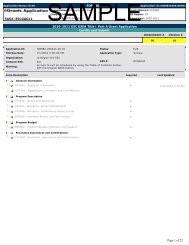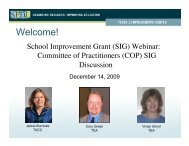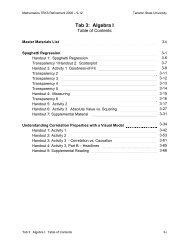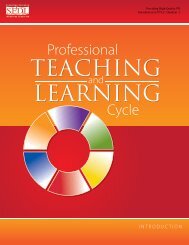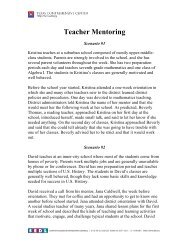The Professional Teaching and Learning Cycle: Introduction - Texas ...
The Professional Teaching and Learning Cycle: Introduction - Texas ...
The Professional Teaching and Learning Cycle: Introduction - Texas ...
You also want an ePaper? Increase the reach of your titles
YUMPU automatically turns print PDFs into web optimized ePapers that Google loves.
<strong>Professional</strong> <strong>Teaching</strong> <strong>and</strong> <strong>Learning</strong> <strong>Cycle</strong><br />
SEDL<br />
<strong>and</strong> schools to operate, providing job-embedded, ongoing professional development in a<br />
collaborative, trusting environment. Most schools <strong>and</strong> districts will need support from an<br />
external facilitator or technical assistance provider for the first few years to help develop PTLC<br />
<strong>and</strong> incorporate it into their educational system (Rust, 2001). Over time, however, the external<br />
facilitator can gradually shift responsibility for support to internal leaders, thus decreasing the<br />
school’s dependence on external consultants for ongoing, sustainable improvement.<br />
One of the key strengths of PTLC is its design as a job-embedded professional learning process<br />
that is ongoing <strong>and</strong> results driven. According to multiple correlation studies on teacher<br />
quality (Darling-Hammond, 2000; Darling-Hammond, Hightower, Husb<strong>and</strong>s, LaFors, Young,<br />
& Christopher, 2003), higher levels of student achievement are associated with educators who<br />
participate in sustained professional development grounded in content-specific pedagogy.<br />
Continuous professional learning that improves teacher outcomes, in turn, impacts student<br />
outcomes. Studies indicate that when teachers improve their instructional practice, student<br />
achievement also improves (Fishman, Marx, Best, & Tal, 2003; Guskey, 2000; Kamil, 2003).<br />
<strong>The</strong> design of professional development, therefore, is critical to school improvement. A<br />
longitudinal study conducted by the National Partnership for Excellence <strong>and</strong> Accountability<br />
in <strong>Teaching</strong> (1999) identified several characteristics that proved most effective in positively<br />
influencing teacher practice. Three of those identified characteristics that are strongly<br />
emphasized in PTLC are collective participation, active learning with opportunities for direct<br />
application, <strong>and</strong> coherence with school goals <strong>and</strong> state st<strong>and</strong>ards.<br />
Convergent evidence (Fern<strong>and</strong>ez, 2003; Joyce & Showers, 2002; Poglinco, Bach, Hovde,<br />
Rosenblum, Saunders, & Supovitz, 2003; Reeves, 2004; Seagall, 2004; Sparks & Hirsch, 2000;<br />
Wheelan, 2005) also suggests that professional development should<br />
• provide opportunities for teachers to build their content <strong>and</strong> pedagogical knowledge<br />
<strong>and</strong> to examine practices;<br />
• be research based <strong>and</strong> engage adults in the learning approaches they will use with<br />
their students;<br />
• provide opportunities for teachers to collaborate with colleagues <strong>and</strong> other experts<br />
to improve their practices; <strong>and</strong><br />
• include a design—based on student learning data—that will be evaluated <strong>and</strong><br />
improved continuously.<br />
Substantial support from school leaders is required for implementing, supporting, <strong>and</strong><br />
sustaining high-quality professional development (Cotton, 2003; NAESP, 2001). In addition,<br />
strong leadership is needed for fostering a culture of collaboration <strong>and</strong> problem solving<br />
(Marzano, Waters, & McNulty, 2005). Good leaders<br />
• set clear academic goals <strong>and</strong> monitor progress toward those goals (Cotton, 2003;<br />
Joyce & Showers, 2002; Marzano et al., 2005; NAESP, 2001; Reeves, 2004);<br />
• link those goals to professional development (Joyce & Showers, 2002; Reeves, 2004);<br />
<strong>and</strong><br />
• monitor implementation of innovations <strong>and</strong> changes in the instructional program<br />
(Cotton, 2003; Marzano et al., 2005; NAESP, 2001).



